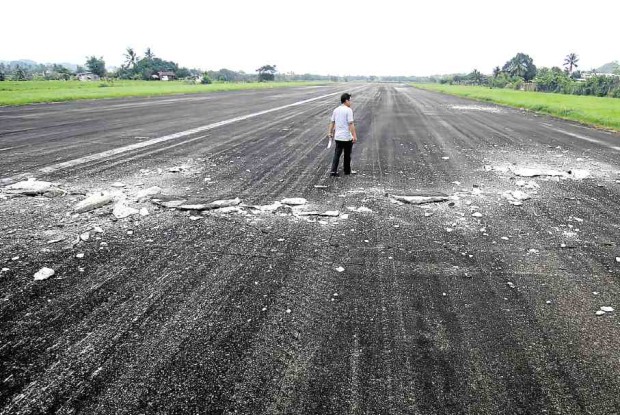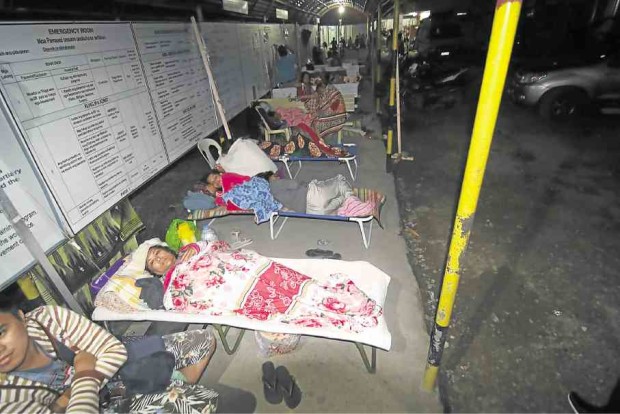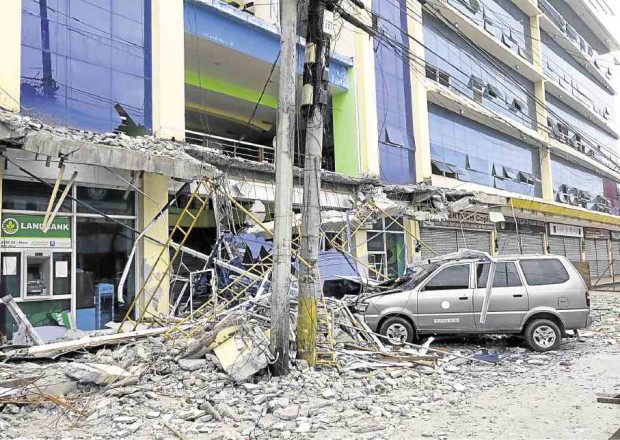State of emergency declared in Surigao

An airport official inspects the damage to the runway that forced the closure of the Surigao airport following the 6.7-magnitude earthquake that hit Friday, Feb. 10, 2017. AFP
SURIGAO CITY — Local officials declared a state of emergency on Saturday after this southern Philippine city was rocked by the most powerful earthquake to strike it in nearly 140 years, killing at least six people, cracking roads and buildings, and shutting down the airport.
More than 100 people also were injured in the late Friday night 6.7-magnitude earthquake that sent hundreds of residents fleeing their homes in panic and heading to high ground.
The emergency declaration would allow faster release of disaster funds for quake victims, whose number is still to be determined, Mayor Ernesto Matugas said.
Presidential spokesperson, Ernesto Abella, assured those affected that the government was ready to assist them.
“These are trying times and our hearts go out to Surigao,” he told reporters.
People rushed out of their homes when the earthquake struck at 10:03 p.m. on Friday. Fearing a tsunami, they sought high ground in the moonlight and spent the night in parks and emergency shelters.

Hospital patients are taken to safety—a pedestrian waiting shed—in the wake of a 6.7-magnitude earthquake, that struck overnight in Surigao City. AFP
The stream of people, including children and their pets, and speeding motorists caused gridlock. Most headed to the elevated Provincial Capitol grounds, where a gymnasium serves as an evacuation area during floods and other disasters.
Lt. Ryan Layug, the civil-military operations officer of the 30th Infantry Battalion, reported that Anao-aon Bridge in San Francisco, Surigao del Norte, collapsed and roads were also damaged.
“Some roads and other bridges have tension cracks,” said Manny Kong of the Surigao City disaster management council.
The quake caused deep cracks on the runway of the Surigao City Airport, forcing incoming flights on Saturday to divert to Butuan City in Bukidnon province.
Aviation authorities advised airlines to reroute flights to Butuan, about two hours away by land. Flights out of the city were canceled.
Surigao City Vice Mayor Alfonso Casurra said those who died were hit or pinned by falling debris.
Annette Villaces of the City Disaster Risk Reduction and Management Council identified five of fatalities as Lorenzo Degenio, 84; Wilson Lito, 35; Roberto Eludo, 40; Roda Justina Taganahan, 83, who suffered a heart attack; and Wenefreda Aragon Bernal, 66; who was hit by a collapsed wall.
The Caraga regional disaster management office reported that a 4-year-old boy, JM Anar, also died.
Most of the injured were brought to the Caraga Regional Hospital, but only around 15 remained and the others were discharged after receiving first aid, according to hospital spokesperson Ma. Ana Dagcota.

Debris from a stricken building rain on a government vehicle following Friday night’s earthquake. AP
The hospital has declared a “code blue” alert, which means at least 50 percent of all the staff have to report for duty.
Renato Solidum, chief of the Philippine Institute of Volcanology and Seismology, said that at least 89 aftershocks had been recorded by Saturday morning and more could be expected but they were unlikely to cause significant damage.
Friday’s quake was the strongest since the city was rocked by an estimated 7.4-magnitude quake in 1879, he said.
The shaking was strongest in Surigao City and was felt in various intensities in other parts of northern Mindanao, including Gingoog, Iligan and Cagayan de Oro cities, and in central and eastern Visayas—Cebu, Southern Leyte, Ormoc City, and as far away to the northwest as Camiguin Island and Dumaguete City.
The quake’s epicenter was located about 16 kilometers northwest of Surigao City at a depth of about 10 km under the sea. No tsunami was generated by the temblor, which was caused by the movement of the Surigao segment of the Philippine fault line.
The social welfare department reported that at least eight houses were destroyed and more than 300 others were damaged in 28 barangays in Surigao City, which suffered power outages along with the towns of Malimono and San Francisco.
The local water utility said water supply had been cut off as pipes were damaged. It said P1.7 million in pipes and facilities had been damaged.
City engineer Gil Menor said infrastructure damage was still being assessed, although he described the initial evaluation as “the worst I have ever seen.”
“Several commercial buildings sustained disaligned columns that make it unsafe for anyone to enter. I advise that these buildings cease operations for now until we can finish our own inspection,” Menor reported to the city disaster council.
Some walls of the two-story Gaisano Mall, one of the city’s largest structures, suffered cracks. Shattered windows sent shards and heavy rubble onto the street.
Surigao del Norte Gov. Sol Matugas said hours after the quake struck, the province was still in chaos and most of the people were still in a state of shock.
She ordered immediate deployment of personnel to help quake survivors cope with anxiety and grief amid aftershocks that sent people rushing out into the streets.
“The people are really nervous and weary with the aftershocks and really need psychological counseling,” she added.
“The shaking was so strong I could hardly stand,” coast guard personnel Rayner Neil Elopre told The Associated Press.
Village leaders asked residents to move to a school building on higher ground, Elopre said, pausing briefly during a mild aftershock while talking on the phone.
Hospital staff temporarily brought bedridden patients outside until the aftershocks eased, the French news agency, Agence France-Presse (AFP), reported.
Local journalist Roel Catoto said when he visited a hospital emergency room after the quake, what he found was “mass hysteria.”
“There were a lot of wounded patients coming in and all the patients who were (already) confined were rushing outside. They were afraid the hospital would collapse,” he told AFP.
Writing on his Facebook page, Catoto said some of their household stuff were damaged but he and his family were unharmed.
“I thought I’m gonna die. The quake was so strong here in Surigao City. People are still panicking, seeking higher ground,” he wrote. WITH REPORTS FROM DANILO V. ADORADOR III, FRANKLIN A. CALIGUID, JAYMEE T. GAMIL, ALLAN NAWAL, JEANNETTE T. ADRANEDA, AFP and AP